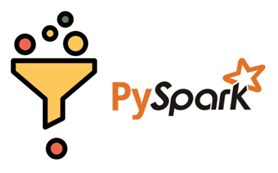
Spark is written in Scala and runs on the JVM and we can use all the features of it in python through PySpark. Programs written in PySpark can be submitted to a Spark cluster and run in a distributed manner.
PySpark is a Python API for Spark to support the collaboration of Apache Spark and Python.

Actually Apache Spark is made up of several components and at its core; Spark is a generic engine for processing large amounts of data.
A PySpark program isn’t that much different from a regular Python program, but the execution model can be very different from a regular Python program, especially if we’re running on a cluster.
Advantages of using PySpark:
- Python is almost 29 years old language in the programming era which is easy to learn and implement
- Python has a very strong community support to deal with most of the problems
- Py4J is a popular library which is integrated within PySpark and allows python to dynamically interface with JVM objects.
- It provides simple and comprehensive API
- With Python, the readability of code, maintenance, and familiarity is far better
- It features various options for data visualization, which is difficult using Scala or Java
How to setup PySpark on your machine?
Version — spark-3.0.0-bin-hadoop3.2
Notes — create spark directory on your desktop and put the above spark version there and then create the three system variables –
SPARK_HOME: this variable must be mapped with your spark directory,
HADOOP_HOME: this variable should be mapped with your Hadoop directory inside the spark directory such as %SPARK_HOME%\hadoop
PYTHONPATH: this variable should be mapped with your python directory inside the spark directory such as %SPARK_HOME%\python;%SPARK_HOME%\python\lib\py4j-0.10.9-src.zip:%PYTHONPATH%
Components of PySpark
- Cluster — Cluster is nothing more than a platform to install Spark; Apache Spark is a Big Data processing engine. Spark can be run in distributed mode on the cluster, with a least one driver and a master, and others as Spark workers. The Spark driver interacts with the master to find out where the workers are, and then the driver federates tasks to the workers for computation.
- SparkContext is the entry gate of Apache Spark functionality. The most important step of any Spark driver application is to generate SparkContext. It acts as the master of the Spark application
- SQLContext is the main entry point for Spark SQL functionality. A SQLContext can be used create DataFrame, register DataFrame as tables, execute SQL over tables, cache tables, and read parquet files.
- Native Spark: If we use Spark data frames and libraries, then Spark will natively parallelize and distribute our task. First, we’ll need to convert the Pandas data frame to a Spark data frame and then do the needful business operations.
- Thread Pools: The multiprocessing library can be used to run concurrent Python threads, and even perform operations with Spark data frames.
- Pandas UDFs — With this feature, we can partition a Spark data frame into smaller data sets that are distributed and converted to Pandas objects, where our function is applied, and then the results are combined back into one large Spark data frame.
How does PySpark work?
By default, Spark’s scheduler runs jobs in FIFO fashion. Each job is divided into “stages” (e.g. map and reduce phases), and the first job gets priority on all available resources while its stages have tasks to launch, then the second job gets priority, etc. If the jobs at the head of the queue don’t need to use the whole cluster, later jobs can start to run right away, but if the jobs at the head of the queue are large, then later jobs may be delayed significantly.
- MultiThreading — The threading module uses threads where threads run in the same memory space. Since threads use the same memory, precautions have to be taken or two threads will write to the same memory at the same time. It is a good option for I/O-bound applications. Benefits –
a. Multithreading is concurrency
b. Multithreading is for hiding latency
c. Multithreading is best for IO
2. MultiProcessing — The multiprocessing module uses processes where processes have separate memory. Multiprocessing gets around the Global Interpreter Lock and it takes advantage of multiple CPUs & cores. Benefits –
a. Multiprocessing is parallelism
b. Multiprocessing is for increasing speed
c. Multiprocessing is best for computations
3. Map() function
map() applies a function to each item in an iterable, but it always produces a 1-to-1 mapping of the original items.
Key features of PySpark — PySpark comes with various features as given below:
- Real-time Computation — PySpark provides real-time computation on a large amount of data because it focuses on in-memory processing. It shows the low latency
- Support Multiple Language — PySpark framework is suited with various programming languages like Scala, Java, Python, SQL, and R. Its compatibility makes it the preferable frameworks for processing huge datasets
- Caching and disk constancy — PySpark framework provides powerful caching and good disk constancy
- Swift Processing — It allows us to achieve a high data processing speed, which is about 100 times faster in memory and 10 times faster on the disk as stated by their development team
- Works well with RDD — Python programming language is dynamically typed, which helps when working with RDD





No comments:
Post a Comment